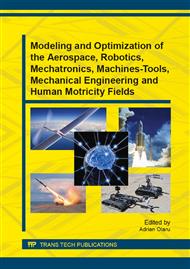[1]
J. Jeswiet, F. Micari, G. Hirt, A. Bramley, J. Duflou, J. Allwood, Asymmetric single point incremental forming of sheet metal, CIRP Annals Manufacturing Technology Volume 54, Issue 2 (2005), 623-650.
DOI: 10.1016/s0007-8506(07)60021-3
Google Scholar
[2]
M. Sasso, M. Callegari, D. Amodio, Incremental forming: an integrated robotized cell for production and quality control, Meccanica 43 (2008), 153–163.
DOI: 10.1007/s11012-008-9124-8
Google Scholar
[3]
G. Ambrogio, L. De Napoli, L. Filice, F. Gagliardi, Application of Incremental Forming process for high customized medical product manufacturing, Journal of Materials Processing Technology (2005), 156–162.
DOI: 10.1016/j.jmatprotec.2005.02.148
Google Scholar
[4]
V. Oleksik, A. Pascu, C. Deac, R. Fleaca, M. Roman, Numerical Simulation of the Incremental Forming Process for Knee Implants, Proc. X International Conference on Computational Plasticity, Fundamental and Applications (2009).
DOI: 10.1063/1.3457520
Google Scholar
[5]
M. Rauch, Tool path programming optimization for incremental sheet forming applications, Computer-Aided Design 41 (2009), 877-885.
DOI: 10.1016/j.cad.2009.06.006
Google Scholar
[6]
N. Cofaru, V. Oleksik, A. Pascu, Finite element simulations regard different alternatives of the single point incremental forming process, Proceedings of the 1st Wseas International Conference on Visualization, Imaging and Simulation (2008).
Google Scholar
[7]
V. Oleksik, A. Pascu, A. Găvruş, M. Oleksik, Experimental studies regarding the single point incremental forming process, Academic Journal of Manufacturing Engineering, Vol. 8, No. 2 (2010), 51-56.
DOI: 10.1063/1.4806872
Google Scholar
[8]
T. Schafer, R.D. Schraft, Incremental sheet metal forming by industrial robots, Rapid Prototyping Journal 11/5 (2005), 278-286.
DOI: 10.1108/13552540510623585
Google Scholar
[9]
H. Meier, B. Buff, R. Laurischkat, V. Smukala, Increasing the part accuracy in dieless robot-based incremental sheet metal forming, CIRP Annals - Manufacturing Technology 58 (2009), 233–238.
DOI: 10.1016/j.cirp.2009.03.056
Google Scholar
[10]
Q. Shen, J. Gausemeier, J. Bauch, R. Radkowski, A cooperative virtual prototyping system for mechatronic solution elements based assembly, Advanced Engineering Informatics 19 (2005), 169–177.
DOI: 10.1016/j.aei.2005.05.011
Google Scholar
[11]
T. Huang, C.W. Kong, H.L. Guo, A. Baldwin, H. Li, A virtual prototyping system for simulating construction processes, Automation in Construction, 16 (2007), 576–585.
DOI: 10.1016/j.autcon.2006.09.007
Google Scholar


